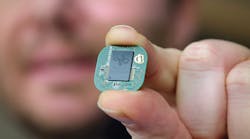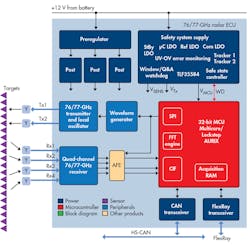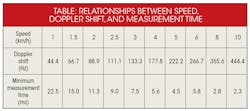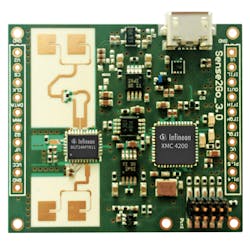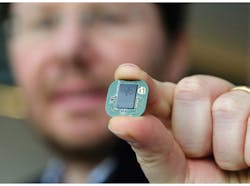This file type includes high-resolution graphics and schematics when applicable.
With chip-scale systems available both in microwave and millimeter-wave frequencies, commercial adoption of radar sensors for industrial, transportation, and consumer applications has risen sharply. In many ways, it is a familiar story of silicon integration, and we can see how issues such as form factor and power consumption are addressed in successive design iterations.
Most publicly recognized work in compact radar systems has centered on automotive applications. Introduced at the end of the 1990s as a premium feature in luxury cars, applications have evolved from warning systems to active driver assistance.
Installed in about 10% of vehicles on the road today, radar-based driver assistance is now commonly available in both high-end and mid-priced autos, and well on its way to becoming standard equipment. As the industry integrates autonomous driving functionality, it’s expected that light vehicles will require at least five radar systems to provide 360-degree coverage for sense and control.
Across a large number of automotive applications, 77-GHz systems meet requirements for range (up to 250 meters) and the ability to accurately distinguish multiple objects. To provide high spatial resolution, 77-GHz-class systems actually utilize 4 GHz of bandwidth. Beginning in Europe in the early 2000s, regulatory bodies and industry harmonized on this frequency allocation, spurring market growth while allowing suppliers to develop signal propagation and antenna design expertise.
The cost curve for advanced-driver-assistance-system (ADAS) radars started arcing downward around 2008/9 in conjunction with the first commercial-scale production of fully automotive-qualified silicon-germanium (SiGe) integrated circuits (ICs) operating at 77 GHz. Previously the realm of gallium arsenide (GaAs), SiGe allows for higher integration, resulting in a two-chip (multichannel transmit and multichannel receive) sets replacing up to 8 GaAs chips.
The next step in this evolution was the ability to use embedded wafer-level ball-grid-array (eWLB) packaging, which was originally developed for consumer-electronics applications. Mass-production-friendly packaging lowered assembly cost for complete radar modules.
There’s also the matter of the radar’s electronic control unit (ECU), which has more complexity in order to meet required safety systems and design resilience for automotive operation (Fig. 1). However, it has both the precision and scalability from mid- to long-range operation to reach volume series production.
Today, 77-GHz class radar modules weighing in at about 200 g per module are implemented by several Tier One suppliers. These companies and the auto OEMs have gained the skills in beamfohttp://sourceesb.com/manufacturers/search?q=+Infineonrming and antenna-array design needed for accurate sensing of multiple objects at variable speeds and even different heights relative to the sensing vehicle. Operating power range is typically measured in low single-digit watts, well in line with the power requirements for both combustion and electric vehicles.
Short- to Mid-Range for Autos and Beyond
In the mid- to short-range class of automotive radar applications (up to 100 meters), lower system cost may be achieved by implementing a 24-GHz design. Single-chip transceiver implementations (typically with dual transmit and receive channels) can be matched with additional receivers for the appropriate antenna schemes.
The reduced cost of microwave-frequency radar systems also makes the technology attractive in commercial-building automation applications. Previously the domain of passive-infrared (PIR) or even video systems, 24-GHz-band radar supports longer range detection, direction intelligence, and higher overall sensitivity at a relatively small cost premium. PIR sensors, on the other hand, have a relatively short range (about 10 meters); moreover, the sensor target must be moving, and there must be a significant difference between a target and the surrounding environment.
Used for presence detection in buildings, radar senses even non-moving objects (i.e., desk-bound workers) and avoids the tendency of PIR to turn off lights when people are sitting still. In an application such as automatic doors, radar provides longer range and can distinguish between passers-by and people approaching the entrance. Available ICs with a single transmit channel and dual receive channels make it possible to calculate position, proximity, speed, and direction of movement. This creates a rich data set for radar-based security systems.
While continuously operating radar would most likely require line power, a duty-cycling technique can be used to lower power requirements for battery-driven applications. The table denotes the Doppler shifts associated with various measured speeds, showing that a measurement period of about 10 ms enables accuracy to approximately 2.5 km/h. An update rate of 0.5 seconds can detect targets moving at up to 20 km/h—a rate that makes it easy to track a human or small animal. At this 0.5-second duty cycle, power consumption of the radar IC drops from 528 mW (using a 3.5-V supply) to just 12 mW.
With all circuitry for a radar sensor implemented in a single device, available 24-GHz transceivers eliminate the need to match external components and lay out RF transmission lines on the system printed-circuit board (PCB). This high level of integration can save up to 70% of the board area versus that of a discrete-based solution.
To illustrate potential system size, an Infineon-supplied development board (Fig. 2)—including both the radar front-end and controller MCU—measures just 4 × 3.5 cm. The board is useful for prototyping a compact radar sensor for domestic- or commercial-building automation applications.
Radar at the Next Level
Recently announced details about Google’s Soli radar project illustrate that 60-GHz mm-wave technology is near-ready for prime time in consumer applications. Soli represents a leapfrog in the current state of the art in terms of the packaged system size and power requirements.
As envisioned by engineers from both Google’s Advanced Technology and Projects (ATAP) group and Infineon, the goal of the Soli project was a device control system that could be implemented across any type of CE product, with particular emphasis on devices with little or no “real estate” available for the human-machine interface. This meant a combination of miniaturization and reduction of power draw by orders of magnitude compared to existing devices. And this must be achieved at a price target that, while not disclosed as of yet, must be compatible with targeted consumer-electronics applications, such as smartwatches, gesture-controlled audio systems, and Internet of Things (IoT) devices.
A little more than one year ago, Infineon produced a 14-mm2 development chip for release to application developers. However, it still required a standalone PC as a controller and drew 1.2 W during operation. Twelve months later, a new iteration of the IC measuring 12.5 mm2 draws just 0.054 W and works with CE-class MCUs (Fig. 3). End-user systems are in development now, and the next wave of developers will gain access to the technology during Fall 2016.
As we’ve seen, the growing ubiquity of radar is a tale of integration and the ability to implement RFICs in silicon processes. To this end, Infineon and other IC manufacturers are actively working to reduce the cost of radar sensors to extend the commercially viable price-performance ratio into broader markets.
Timetables for these programs indicate early commercial availability within the next year for millimeter-wave ICs. However, testing and deployment may take longer, as will ramping to scale. For the near term, and likely longer in the more rigorously qualified automotive and industrial segments, SiGe-based systems will probably be the preferred option for some time.
Suresh Ram, Director of RF & Sensors
Kim Lee is Principal Applications Engineer
Infineon Technologies Americas
Looking for parts? Go to SourceESB.
This file type includes high-resolution graphics and schematics when applicable.
